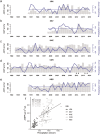Cross-Site Comparisons of Dryland Ecosystem Response to Climate Change in the US Long-Term Ecological Research Network
- PMID: 36034512
- PMCID: PMC9405733
- DOI: 10.1093/biosci/biab134
Cross-Site Comparisons of Dryland Ecosystem Response to Climate Change in the US Long-Term Ecological Research Network
Abstract
Long-term observations and experiments in diverse drylands reveal how ecosystems and services are responding to climate change. To develop generalities about climate change impacts at dryland sites, we compared broadscale patterns in climate and synthesized primary production responses among the eight terrestrial, nonforested sites of the United States Long-Term Ecological Research (US LTER) Network located in temperate (Southwest and Midwest) and polar (Arctic and Antarctic) regions. All sites experienced warming in recent decades, whereas drought varied regionally with multidecadal phases. Multiple years of wet or dry conditions had larger effects than single years on primary production. Droughts, floods, and wildfires altered resource availability and restructured plant communities, with greater impacts on primary production than warming alone. During severe regional droughts, air pollution from wildfire and dust events peaked. Studies at US LTER drylands over more than 40 years demonstrate reciprocal links and feedbacks among dryland ecosystems, climate-driven disturbance events, and climate change.
Keywords: ANPP; LTER; climate change; disturbance; drought; wildfire.
© The Author(s) 2022. Published by Oxford University Press on behalf of the American Institute of Biological Sciences.
Figures










Similar articles
-
Long-Term Ecological Research on Ecosystem Responses to Climate Change.Bioscience. 2022 Aug 16;72(9):814-826. doi: 10.1093/biosci/biac021. eCollection 2022 Sep. Bioscience. 2022. PMID: 36034511 Free PMC article. Review.
-
Robust ecological drought projections for drylands in the 21st century.Glob Chang Biol. 2020 Jul;26(7):3906-3919. doi: 10.1111/gcb.15075. Epub 2020 Apr 27. Glob Chang Biol. 2020. PMID: 32342577
-
Climate change-induced vegetation shifts lead to more ecological droughts despite projected rainfall increases in many global temperate drylands.Glob Chang Biol. 2017 Jul;23(7):2743-2754. doi: 10.1111/gcb.13598. Epub 2017 Mar 6. Glob Chang Biol. 2017. PMID: 27976449
-
The consequences of climate change for dryland biogeochemistry.New Phytol. 2022 Oct;236(1):15-20. doi: 10.1111/nph.18312. Epub 2022 Jul 15. New Phytol. 2022. PMID: 35706381
-
Nature-based framework for sustainable afforestation in global drylands under changing climate.Glob Chang Biol. 2022 Apr;28(7):2202-2220. doi: 10.1111/gcb.16059. Epub 2022 Jan 14. Glob Chang Biol. 2022. PMID: 34953175 Review.
Cited by
-
Assessing effective mechanical and chemical strategies for managing Eucosma giganteana (Lepidoptera: Tortricidae) in the perennial oilseed crop, Silphium integrifolium (Asteraceae: Heliantheae).J Insect Sci. 2023 Nov 1;23(6):4. doi: 10.1093/jisesa/iead102. J Insect Sci. 2023. PMID: 37987629 Free PMC article.
-
Long-Term Ecological Research on Ecosystem Responses to Climate Change.Bioscience. 2022 Aug 16;72(9):814-826. doi: 10.1093/biosci/biac021. eCollection 2022 Sep. Bioscience. 2022. PMID: 36034511 Free PMC article. Review.
-
Laser Microdissection: A High-Precision Approach to Isolate Specific Cell Types from Any Plant Species for Downstream Molecular Analyses.Methods Mol Biol. 2023;2642:365-373. doi: 10.1007/978-1-0716-3044-0_19. Methods Mol Biol. 2023. PMID: 36944888
References
-
- Abbott BW, et al. 2021. Tundra wildfire triggers sustained lateral nutrient loss in Alaskan Arctic. Global Change Biology 27: 1408–1430. - PubMed
-
- Abraha M, Chen J, Chu H, Zenone T, John R, Su Y-J, Hamilton SK, Robertson GP.. 2015. Evapotranspiration of annual and perennial biofuel crops in a variable climate. GCB Bioenergy 7: 1344–1356.
-
- Ahlström A, et al. 2015. The dominant role of semi-arid ecosystems in the trend and variability of the land CO2 sink. Science 348: 895–899. - PubMed
-
- Andriuzzi WS, Adams BJ, Barrett JE, Virginia RA, Wall DH.. 2018. Observed trends of soil fauna in the Antarctic Dry Valleys: Early signs of shifts predicted under climate change. Ecology 99: 312–321. - PubMed

